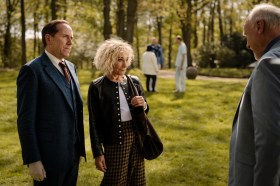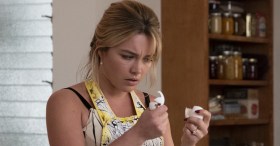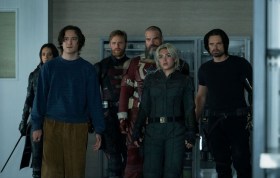Killer Whale: quick links
In the ecosystem of the nature documentary, the host holds a unique position. Traditionally they’re just the icing on the cake, a smooth voice letting us know that seeing animals be devoured is all part of the circle of life. But for many of their nature docos this year, the ABC has gone for a more engaged narrator.
With the recent Dr Ann’s Secret Lives, we were watching Dr Ann as she spent time with a variety of secretive local wildlife. The animals weren’t quite playing second fiddle, but it was always clear that the Doctor was the star of the show.
In The Kimberly, which aired earlier this year, Mark Coles Smith was more of a tour guide, sometimes on camera displaying his local knowledge and connections, other times providing voice-over during some stunning wildlife footage.
Killer Whale: Richard Roxburgh
Now with Killer Whale: Australia’s Megapod, Richard Roxburgh takes on a more traditional role: he’s the narrator, with the scientists – and the killer whales – taking centre stage. It’s the right choice: both the story being told and the footage telling it are impressive enough without a celebrity hanging off the side of a boat.
Six years ago, killer whale researcher John Totterdell was a witness to the first confirmed sighting of a pod of orcas predating – killing, in layman’s terms – an adult blue whale, the largest animal to ever live. The footage is both impressive and a little chilling, the blue whale swatting its tail about while the water turns red as birds circle overhead and the killer whales repeatedly attack.
Watch the Killer Whale: Australia’s Megapod trailer.
The pod was largely made up of female whales, including one known as Split-tip (due to the split in her dorsal fin); it took an hour or so for the blue whale to succumb to repeated attacks. Then, Roxburgh says solemnly, ‘the feeding began’.
Now Totterdell and Doctor Rebecca Wellard are back, first to find the whale’s skeleton, and then to study the pod living off the coast of Western Australia. The location is unique, providing regular summer access to the same whales each year for study. While other killer whale pods around the world are struggling, this particular one is doing well. If they can figure out why, they might be able to help the rest.
Killer Whale: subplots
There’s a number of subplots to the story that unfolds over the next hour. There’s the killer whales themselves, with their complex social structure and language. Do they have their own Aussie accent? All signs point to yes.
Studying them is a fairly hands on process, starting out with recording their sounds and collecting their DNA (by shooting them with harpoons), before later in the documentary visiting a pair of New York neuroscientists who are examining a rare specimen of an orca brain. Those things are huge; it’s no surprise the scientists believe killer whales have their own culture.
There’s also the Totterdell and Wellard’s struggle to collect this information. They’re out on the high seas in boats that can seem very small when the weather turns rough, not to mention their job requires them to get up close to creatures that have the word ‘killer’ in their names.
You don’t have to have been following the news stories about orcas sinking boats over the last few years to realise that these are animals to be respected … even when you’re shooting that them with DNA-collecting harpoons.
Still, just in case you saw Free Willy a few too many times as a child (as one whale watcher confesses she did), we’re repeatedly told orcas are ‘the wolves of the sea’ and the ocean’s ‘apex predator’. Which some viewers may have already figured out, what with the orcas eating a blue whale in front of us at the start of the documentary.
Killer Whale: climax
The climax of Killer Whale: Australia’s Megapod comes when a whale watching boat – big enough to head out in rough seas when the scientists are stuck back on dry land – find a whale pod on the hunt. It turns out they’re chasing down a beaked whale that’s trying to escape. The whales are identified by name: Split-tip is leading the charge, and she doesn’t mess around.
Eventually 35 orcas are involved in the hunt. It would spoil things to reveal how it goes; let’s just say Roxburgh gets to grimly intone the words ‘skinned alive’.
It’s nature in all its blood-soaked glory. Which makes it a fitting conclusion to this engaging look at an animal that, for all its beauty and intelligence, is mainly just really, really good at killing.
Killer Whale: Australia’s Megapod premieres 26 August at 8.30pm on ABC TV and ABC iview.
Discover more screen, games & arts news and reviews on ScreenHub and ArtsHub. Sign up for our free ArtsHub and ScreenHub newsletters.
Actors:
Richard Roxburgh
Director:
Jeff Siberry
Format: Movie
Country: Australia
Release: 26 August 2025





